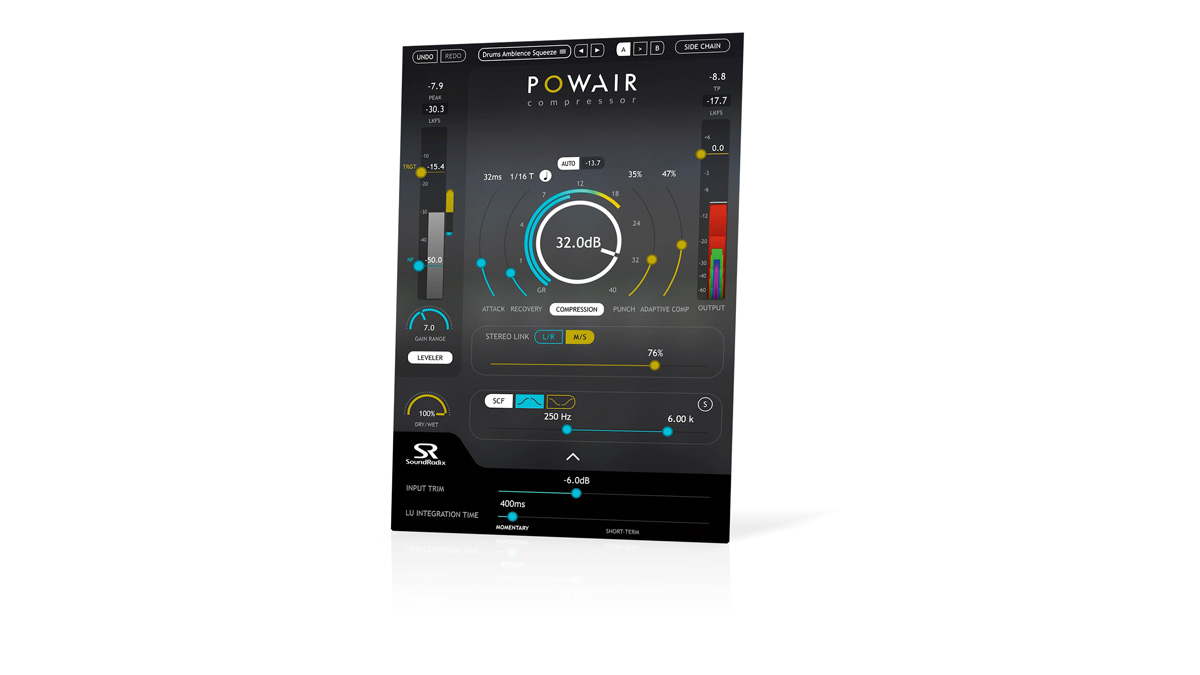MusicRadar Verdict
An absolutely stunning compressor and leveller that no one should be without.
Pros
- +
Wonderfully transparent and precise compression.
- +
Punch and Adaptive features are superb.
- +
Leveler is very useful.
Cons
- -
Moderately high CPU hit.
MusicRadar's got your back
Powair (VST/AU/AAX) is a two-stage dynamics processor for mixing and mastering, from the makers of the equally innovative Drum Leveler and SurferEQ2.
Its futuristic graphical interface gives the expectation of a similarly modern workflow and end result - and happily, it delivers on both counts.
Brains and brawn
First in the signal path is the BS 1770-compliant Leveler, discussed in On the level, below.
After that, it’s on to the compressor itself. A fixed-threshold design with a soft knee, this keeps things admirably simple with its big central Compression knob: simply turn this clockwise to increase the input into the compressor and thus the amount of gain reduction applied. The detection circuit can be switched between Stereo and Mid/Side analysis, and the separation between left/right and mid/ sides is adjusted using a percentage slider, enabling everything from fully linked to fully unlinked stereo response.
The Attack and Recovery controls range from 0-100ms and 10-5000ms respectively, and the latter is syncable to host tempo, at note values from 1/64T to 2 bars. This is something we’re always surprised more compressors don’t do, as it can be a real boon for setting up rhythmically defined envelopes.
The first of Powair’s two processing stages is an ITU-BS 1770-compliant K-Weighted Perceived Loudness (LKFS) Leveler. BS 1770 is one of the most widely accepted and ‘proven’ of broadcast standards - indeed, many other standards used around the world are based on it - so the Leveler is a very handy inclusion for mastering.
Deployment is straightforward enough. Set a Loudness Unit target and the Leveler effectively ‘rides’ the volume level of the signal to keep it consistent, lowering it when it exceeds the target and increasing it when it falls below. The detection and response speed is adjustable between 400ms and 5s, and the Noise Floor slider establishes the threshold above which it operates, preventing background noise from bringing the level up. Last but not least, the Gain Range lever limits the amount of positive and negative gain change the Leveller can apply, from 0 (off) to +/-20LU.
The Punch and Adaptive Compression parameters are Powair’s two not-so-secret weapons - both, as far as we’re aware, unique to the plugin. Punch is, to all intents and purposes, a transient limiter, letting you alter the level of the attack stage as well as its shape. At zero, it’s a brickwall, clamping down fully on the attack; but as Punch is raised, the limiting is backed off, increasingly emphasising the transients. The flexibility this brings to the table when processing drums, bass, guitar and other transient-heavy sounds is truly eye-opening.
With the Adaptive slider at 0%, the amount of compression applied is entirely governed by the gain of the input signal, as described above. Dragging Adaptive upwards, however, pushes the compression towards an increasingly averaged amount (guided by the Target setting in the Leveler section), until at 100% it’s constant. The idea behind this is to maximise transparency by preserving the dynamic feel of a part while limiting its dynamic range, and it works a treat, most notably on vocals.
Rather cleverly, the sidechain filter offers band-pass and band-reject options, for focusing compression within or outside the limits of the two frequency sliders (20Hz to 20kHz). The sidechain itself can be keyed off the input, of course, or an external signal.
Finally, the Dry/Wet control allows for parallel compression, and the “smart” Auto Makeup Gain algorithm takes the work out of post- compression level compensation.
Something in the ’Air
Powair is every bit the cutting-edge software compressor, designed to actively assist today’s mixing and mastering engineer in transparently levelling and compressing signals of all kinds. The Leveler is brilliant; the big Compression dial keeps basic operation wonderfully simple; the syncable release time is ideal for use on loops and drums; and the Adaptive compression and Punch features are powerful and groundbreaking. It’s beautiful, and we honestly wouldn’t change a thing.
Computer Music magazine is the world’s best selling publication dedicated solely to making great music with your Mac or PC computer. Each issue it brings its lucky readers the best in cutting-edge tutorials, need-to-know, expert software reviews and even all the tools you actually need to make great music today, courtesy of our legendary CM Plugin Suite.
“A synthesizer that is both easy to use and fun to play whilst maintaining a decent degree of programming depth and flexibility”: PWM Mantis review
“I feel like that song had everything we needed to come back with”: Bring Me The Horizon’s Lee Malia on Shadow Moses, its riff and the secrets behind its tone, and why it was the right anthem at the right time
“I said, ‘Are we sure we can write a song about death?’”: The story of Mike + The Mechanics' classic No.1 The Living Years











